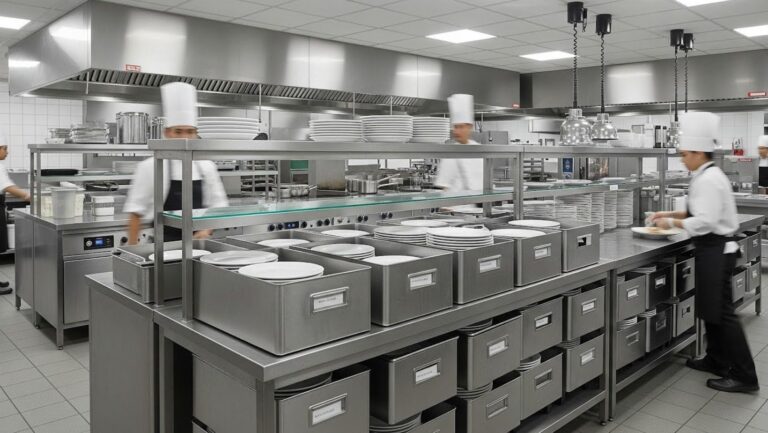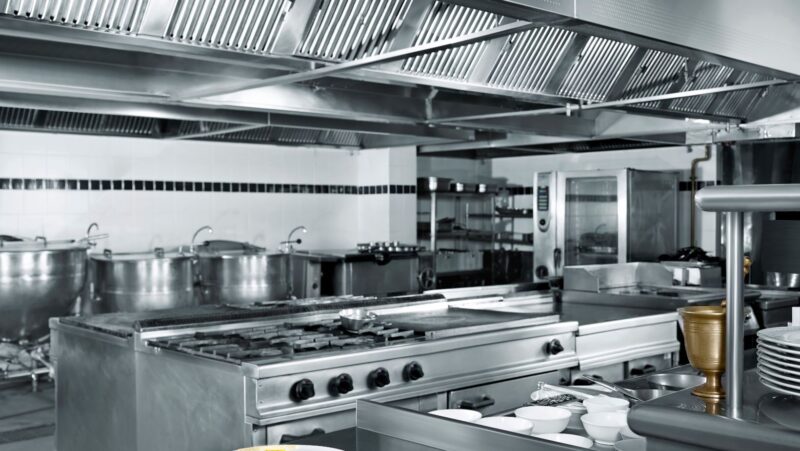In the relentless rhythm of a professional kitchen, milliseconds matter. The difference between seamless service and chaotic delays often comes down to one fundamental principle: intentional organisation. Commercial kitchens that assign dedicated containers for each ingredient and tool operate with surgical precision, while those relying on makeshift solutions constantly fight against growing entropy.
The True Price of Disarray
Chaos manifests in subtle but costly ways throughout unprepared kitchens. Valuable minutes evaporate as chefs rummage through overcrowded shelves searching for specific ingredients, while stacks of unprotected plates teeter precariously without proper storage boxes for plates. Mystery containers of uncertain age lurk in walk-in corners, creating food safety hazards. Staff frustration builds as simple tasks – like retrieving clean dishware – require disproportionate effort. These aren’t isolated incidents but symptoms of inadequate systems that ultimately impact customer experience and profitability.
Purpose-Built Containment Solutions
Storage boxes designed specifically for commercial use address these challenges through thoughtful engineering. Heavy-duty polymers withstand industrial dishwashers’ punishing cycles while maintaining structural integrity. Standardised dimensions create predictable workflows where every container fits its designated space. Secure latching mechanisms prevent spills during transport or stacking. These features transform simple vessels into critical kitchen infrastructure.
Material Intelligence for Diverse Needs
Commercial kitchens handle an extraordinary range of substances, each demanding appropriate housing. Dry goods require airtight protection against moisture and pests, while fresh herbs need breathable environments that prevent premature wilting. High-quality containers meet these varied needs through specialised materials – stainless steel for acidic ingredients, antimicrobial plastics for raw proteins, and glass-front designs for visual inventory management.
Spatial Logic in Practice
Efficient kitchens follow biomechanical principles in container placement. Frequently used items occupy prime real estate between waist and shoulder height. Heavy containers rest on sturdy lower shelves to minimise lifting strain. Related ingredients group together to create intuitive workflow pathways. This thoughtful spatial organisation reduces unnecessary movement that cumulatively wastes hours each service.
The Cognitive Benefits of Order
Few chefs consider how disorganisation taxes mental bandwidth. When every item has a designated container in a logical location, staff operate with reduced cognitive load. This mental clarity manifests in faster decision-making during rushes, improved plating consistency, and enhanced ability to troubleshoot service challenges. The psychological impact extends to staff retention – cooks stay longer in environments where they aren’t constantly battling chaos.
Hygiene Through Separation
Food safety improves exponentially when ingredients maintain distinct housing. Dedicated containers prevent cross-contamination between allergens or raw and cooked foods. Premium options feature non-porous surfaces that resist bacterial penetration and can withstand sanitising temperatures. Clear labelling systems ensure proper rotation and prevent accidental misuse of ingredients.
Inventory Control Revolutionised
Standardised containers transform inventory management from a guessing game to an exact science. Uniform sizing allows precise space planning and quantity estimation. Transparent designs enable instant visual stock assessment. Integrated measurement markings eliminate separate portioning steps. These systematic approaches prevent both over-ordering waste and last-minute shortages that disrupt service flow.
Durability That Pays Dividends
Commercial environments demand containers that endure years of punishing use.
The best solutions withstand extreme temperature swings, repeated impacts, chemical cleaners, and heavy stacking without failure. While requiring greater initial investment, these durable performers outlast dozens of disposable alternatives while maintaining consistent performance.
Implementing Lasting Change
Transitioning to an organised system requires deliberate planning. Successful kitchens phase in changes during slower periods, training staff on new protocols. They begin with high-impact areas like proteins or allergens before expanding system-wide. Maintenance routines ensure continued functionality – regular cleaning, gasket inspections, and label updates preserve system integrity.
The Ripple Effects of Order
Beyond immediate time savings, organised container systems create cascading benefits. Food costs drop through reduced waste and better portion control. Staff injuries decrease with ergonomic storage solutions. Customer satisfaction improves as service becomes more consistent. These cumulative advantages ultimately separate thriving establishments from those constantly battling operational fires.
In professional kitchens where consistency equals reputation, dedicated containers represent more than storage – they become the framework for excellence. By giving every item its proper home, chefs create environments where creativity flourishes unimpeded by avoidable disorder. The investment in proper organisation pays continuous dividends in saved time, reduced stress, and elevated culinary execution.


